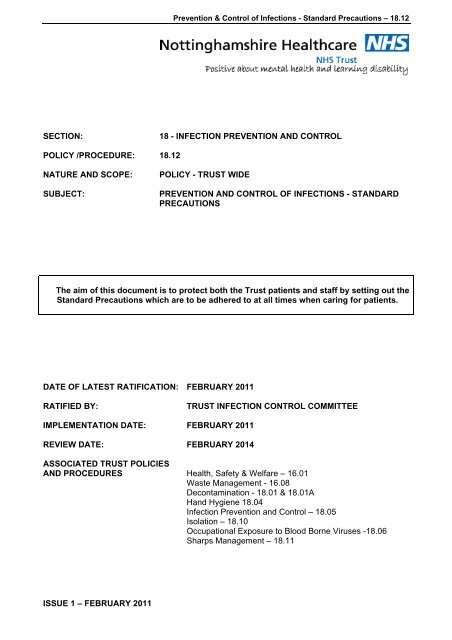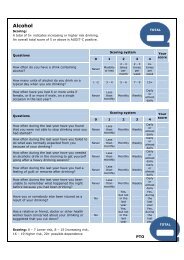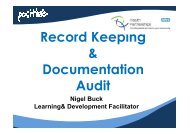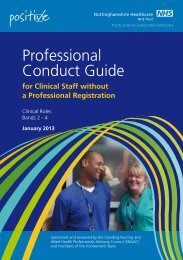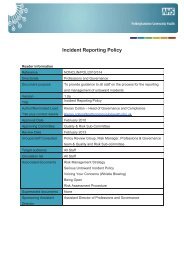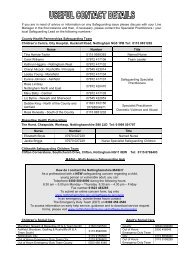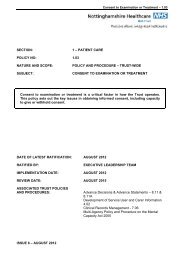Prevention and Control of Infections - Standard Precautions Policy
Prevention and Control of Infections - Standard Precautions Policy
Prevention and Control of Infections - Standard Precautions Policy
You also want an ePaper? Increase the reach of your titles
YUMPU automatically turns print PDFs into web optimized ePapers that Google loves.
<strong>Prevention</strong> & <strong>Control</strong> <strong>of</strong> <strong>Infections</strong> - St<strong>and</strong>ard <strong>Precautions</strong> – 18.12<br />
SECTION:<br />
18 - INFECTION PREVENTION AND CONTROL<br />
POLICY /PROCEDURE: 18.12<br />
NATURE AND SCOPE:<br />
SUBJECT:<br />
POLICY - TRUST WIDE<br />
PREVENTION AND CONTROL OF INFECTIONS - STANDARD<br />
PRECAUTIONS<br />
The aim <strong>of</strong> this document is to protect both the Trust patients <strong>and</strong> staff by setting out the<br />
St<strong>and</strong>ard <strong>Precautions</strong> which are to be adhered to at all times when caring for patients.<br />
DATE OF LATEST RATIFICATION: FEBRUARY 2011<br />
RATIFIED BY:<br />
TRUST INFECTION CONTROL COMMITTEE<br />
IMPLEMENTATION DATE: FEBRUARY 2011<br />
REVIEW DATE: FEBRUARY 2014<br />
ASSOCIATED TRUST POLICIES<br />
AND PROCEDURES Health, Safety & Welfare – 16.01<br />
Waste Management - 16.08<br />
Decontamination - 18.01 & 18.01A<br />
H<strong>and</strong> Hygiene 18.04<br />
Infection <strong>Prevention</strong> <strong>and</strong> <strong>Control</strong> – 18.05<br />
Isolation – 18.10<br />
Occupational Exposure to Blood Borne Viruses -18.06<br />
Sharps Management – 18.11<br />
ISSUE 1 – FEBRUARY 2011
<strong>Prevention</strong> & <strong>Control</strong> <strong>of</strong> <strong>Infections</strong> - St<strong>and</strong>ard <strong>Precautions</strong> – 18.12<br />
NOTTINGHAMSHIRE HEALTHCARE NHS TRUST<br />
PREVENTION AND CONTROL OF INFECTIONS<br />
STANDARD PRECAUTIONS<br />
CONTENTS<br />
1.0 Introduction<br />
2.0 <strong>Policy</strong> Principles<br />
3.0 Definitions<br />
4.0 Duties<br />
5.0 St<strong>and</strong>ard <strong>Precautions</strong><br />
6.0 H<strong>and</strong> Hygiene<br />
7.0 Personal Protective Equipment<br />
7.2 Gloves<br />
7.3 Disposable Plastic Aprons<br />
7.4 Face Masks/Eye Protection<br />
8.0 Sharps Management<br />
8.9 Inoculation injury<br />
9.0 Blood <strong>and</strong> Body Fluid Spillages<br />
10.0 Waste Management<br />
10.2 Clinical Waste<br />
11.0 Laundry<br />
11.2 Definitions<br />
11.3 Use <strong>of</strong> suitable bags<br />
11.4 Patients Personal Clothing<br />
12.0 Decontamination <strong>of</strong> equipment<br />
13.0 Environment<br />
14.0 Implementation<br />
15.0 Training<br />
16.0 Target Audience<br />
17.0 Review Date<br />
18.0 Consultation<br />
19.0 Relevant Trust Policies<br />
20.0 Monitoring compliance<br />
21.0 Equality Impact Assessment<br />
22.0 Legislation compliance<br />
23.0 Champion <strong>and</strong> Expert Writer<br />
24.0 References /Source Documents<br />
Appendix 1 Five Moments for H<strong>and</strong> Hygiene<br />
Appendix 2 Record <strong>of</strong> Changes<br />
Appendix 3 Record <strong>of</strong> Employee Having Read the <strong>Policy</strong><br />
ISSUE 1 – FEBRUARY 2011 1
<strong>Prevention</strong> & <strong>Control</strong> <strong>of</strong> <strong>Infections</strong> - St<strong>and</strong>ard <strong>Precautions</strong> – 18.12<br />
1.0 INTRODUCTION<br />
NOTTINGHAMSHIRE HEALTHCARE NHS TRUST<br />
PREVENTION AND CONTROL OF INFECTIONS<br />
STANDARD PRECAUTIONS<br />
1.1 St<strong>and</strong>ard precautions (formerly know as universal precautions) underpin routine safe<br />
practice <strong>and</strong> is considered effective means <strong>of</strong> protecting healthcare practitioners from<br />
infection. St<strong>and</strong>ard precautions are based on a set <strong>of</strong> principles designed to minimize<br />
exposure to <strong>and</strong> transmission <strong>of</strong> a wide variety <strong>of</strong> micro-organisms between patients <strong>and</strong><br />
staff <strong>and</strong> vice versa. As every patient is a potential infection risk, it is essential that st<strong>and</strong>ard<br />
precautions are used for all patients at all times (Ayliffe 2009).<br />
1.2 This requires the identification <strong>of</strong> high risk procedures rather than high risk individuals to<br />
prevent exposure <strong>of</strong> health care workers (HCWs) to potentially pathogenic organisms<br />
through sharps injuries <strong>and</strong> body fluid splashes. Patients are also protected from crossinfection.<br />
In order to protect patients <strong>and</strong> staff all blood <strong>and</strong> body fluids from all patients<br />
must be considered as infected <strong>and</strong> ensure measures are taken to minimise the risk <strong>of</strong><br />
exposure within everyday practices.<br />
2.0 POLICY/PROCEDURE PRINCIPLES<br />
2.1 The aim <strong>of</strong> this document is to protect both Nottinghamshire Healthcare NHS Trust patients<br />
<strong>and</strong> staff by setting out the St<strong>and</strong>ard <strong>Precautions</strong> which are to be adhered to at all times<br />
when caring for patients.<br />
2.2 This document is based on guidance produced by:<br />
• The Health <strong>and</strong> Social Care Act 2008 Department <strong>of</strong> Health<br />
• National Institute for Health <strong>and</strong> Clinical Excellence CG2 2003<br />
• Royal College <strong>of</strong> Nursing Infection <strong>Control</strong> minimum st<strong>and</strong>ards<br />
• Universal precautions: A review <strong>of</strong> knowledge, compliance <strong>and</strong> strategies to improve.<br />
Gammon <strong>and</strong> Gould Journal <strong>of</strong> Research in Nursing. 2005: 10: 529-547<br />
3.0 DEFINITIONS<br />
3.1 St<strong>and</strong>ard precautions (previously known as universal precautions) are a set <strong>of</strong> activities<br />
which must be used for all patients cared for within healthcare settings <strong>and</strong> are based upon<br />
the risk presented by all contact with blood <strong>and</strong> other body fluids, irrespective <strong>of</strong> know<br />
diagnosis or lifestyle factors <strong>of</strong> patients <strong>and</strong> staff.<br />
4.0 DUTIES<br />
4.1 It is the duty <strong>of</strong> the Director <strong>of</strong> Infection <strong>Prevention</strong> <strong>and</strong> <strong>Control</strong> (DIPC) to ensure healthcare<br />
staff adheres to the principles <strong>of</strong> the policy.<br />
4.2 It is the Ward mangers responsibility to ensure that healthcare staff receives training in the<br />
use <strong>of</strong> st<strong>and</strong>ard precautions <strong>and</strong> that they follow the principles <strong>of</strong> this policy.<br />
4.3 It is the responsibility <strong>of</strong> the Infection <strong>Prevention</strong> & <strong>Control</strong> team to audit the use <strong>of</strong> st<strong>and</strong>ard<br />
precaution<br />
5.0 STANDARD PRECAUTIONS<br />
5.1 St<strong>and</strong>ard precautions are:<br />
ISSUE 1 – FEBRUARY 2011 2
• H<strong>and</strong> Hygiene<br />
• Personal Protective Equipment (PPE)<br />
• Sharps Management<br />
• Blood <strong>and</strong> Body Fluid Spillages<br />
• Waste management<br />
• Safe h<strong>and</strong>ling <strong>of</strong> laundry<br />
• Decontamination <strong>of</strong> Equipment<br />
• Maintenance <strong>of</strong> a Clean Environment<br />
<strong>Prevention</strong> & <strong>Control</strong> <strong>of</strong> <strong>Infections</strong> - St<strong>and</strong>ard <strong>Precautions</strong> – 18.12<br />
5.2 These principles are underpinned by the Health <strong>and</strong> Safety at Work Act (1974) which<br />
requires all employers to ensure that staff are appropriately trained to enable them to work<br />
safely.<br />
5.3 Regulations under <strong>Control</strong> <strong>of</strong> Substances Hazardous to Health (COSHH) (2002) reinforce<br />
the importance <strong>of</strong> risk assessment where there is likelihood <strong>of</strong> contact with body<br />
substances that may contain pathogenic micro organisms.<br />
5.4 Body fluids are:<br />
• Blood<br />
• Cerebrospinal fluid (CSF)<br />
• Peritoneal fluid<br />
• Synovial fluid<br />
• Amniotic fluid<br />
• Semen<br />
• Vaginal secretions<br />
• Pleural fluid<br />
• Breast milk<br />
• Pericardial fluid<br />
• All un-fixed tissue<br />
• Organs <strong>and</strong> body parts<br />
• Urine<br />
• Faeces<br />
• Vomit<br />
• Saliva<br />
6.0 HAND HYGIENE<br />
6.1 H<strong>and</strong> hygiene is the single most important step in reducing the spread <strong>of</strong> disease. Effective<br />
h<strong>and</strong> hygiene will reduce the risk <strong>of</strong> transmission <strong>of</strong> micro-organisms from or via the h<strong>and</strong>s<br />
<strong>of</strong> staff. When working in a clinical setting staff must be bare below the elbows i.e. no long<br />
sleeves, no wrist jewelry including watches <strong>and</strong> no stoned or heavily engraved to reduce<br />
the risk <strong>of</strong> cross infection.<br />
6.2 H<strong>and</strong>s must be decontaminated immediately before <strong>and</strong> after direct patient contact or care<br />
<strong>and</strong> after any activity that could potentially result in h<strong>and</strong>s becoming contaminated e.g:<br />
• Prior to a span <strong>of</strong> duty<br />
• Contact with susceptible sites <strong>of</strong> patients<br />
• H<strong>and</strong>ling, preparing or serving food/beverages/medications<br />
• Direct patient contact<br />
• Clean, aseptic or surgical procedures<br />
6.3 H<strong>and</strong> decontamination must also be carried out after:<br />
• Using the toilet or assisting others with toilet activities<br />
• Using a h<strong>and</strong>kerchief or tissue<br />
• Direct contact with patients<br />
ISSUE 1 – FEBRUARY 2011 3
• Carrying out clean, aseptic or surgical procedures<br />
• Contact with blood or body fluids<br />
• H<strong>and</strong>ling used laundry, equipment or waste<br />
• Removing PPE, especially gloves<br />
<strong>Prevention</strong> & <strong>Control</strong> <strong>of</strong> <strong>Infections</strong> - St<strong>and</strong>ard <strong>Precautions</strong> – 18.12<br />
6.4 Refer to H<strong>and</strong> Hygiene <strong>Policy</strong> <strong>and</strong> Procedure 18.04 <strong>and</strong> also the ‘5 Moments <strong>of</strong> H<strong>and</strong><br />
Hygiene’ (Appendix 1).<br />
6.5 H<strong>and</strong>s that are visibly soiled with contaminated dirt i.e. blood or body fluids must be<br />
washed immediately with liquid soap <strong>and</strong> water.<br />
6.6 The six-step technique for h<strong>and</strong> washing should be used <strong>and</strong> h<strong>and</strong>s dried thoroughly using<br />
disposable paper towels. To maintain good skin integrity a h<strong>and</strong> moisturizer should be used<br />
at least twice daily. H<strong>and</strong> moisturizer must be dispensed from a wall or pump dispenser if<br />
used by more than one person. Individual moisturisers must not be shared as this is a<br />
source <strong>of</strong> infection.<br />
6.7 Any cuts or lesions must be covered with a waterpro<strong>of</strong> dressing.<br />
7.0 PERSONAL PROTECTIVE EQUIPMENT (PPE)<br />
7.1 The main purpose <strong>of</strong> PPE is to protect staff from the risk <strong>of</strong> exposure to blood <strong>and</strong> other<br />
body fluids, <strong>and</strong> reduce the opportunities for transmission <strong>of</strong> micro-organisms from staff to<br />
patient <strong>and</strong> vice versa. The decision to use or wear PPE must be based upon an<br />
assessment <strong>of</strong> the level <strong>of</strong> risk associated with the specific procedure/patient care, activity<br />
or intervention <strong>and</strong> take account <strong>of</strong> good practice st<strong>and</strong>ards <strong>and</strong> current health <strong>and</strong> safety<br />
legislation.<br />
7.2 Gloves<br />
7.2.1 The h<strong>and</strong>s <strong>of</strong> clinical staff are the most common means <strong>of</strong> organisms causing<br />
healthcare associated infections. This risk can be minimized by thorough h<strong>and</strong><br />
washing <strong>and</strong> the correct use <strong>of</strong> gloves.<br />
7.2.2 Gloves must be worn for invasive procedures, contact with sterile sites <strong>and</strong> nonintact<br />
skin on mucus membranes <strong>and</strong> all activities that have been assessed as<br />
carrying a risk <strong>of</strong> exposure to blood, body fluids, secretions <strong>and</strong> excretions or to<br />
sharp or contaminated instruments.<br />
7.2.3 Staff must ensure that the appropriate type <strong>of</strong> glove is selected for each particular<br />
procedure <strong>and</strong> purpose. Gloves that are acceptable to healthcare personnel <strong>and</strong><br />
that conform to the European Community (CE) st<strong>and</strong>ard must be available in a<br />
variety <strong>of</strong> sizes, must be powder <strong>and</strong> latex-free <strong>and</strong> fit for purpose.<br />
7.2.4 Gloves must be worn as a single use item <strong>and</strong> must be put on before patient contact<br />
<strong>and</strong> removed when patient care completed. Gloves must be changed between<br />
caring or different patients (Pratt et al 2007).<br />
7.2.5 Gloves must be disposed <strong>of</strong> as clinical waste following each episode <strong>of</strong> care <strong>and</strong><br />
h<strong>and</strong>s decontaminated following the gloves being removed.<br />
7.2.6 Attempts to clean gloves by washing or with h<strong>and</strong> gel must never be carried out as<br />
the material may become damaged, thus altering their protective properties which<br />
potentially exposes the wearer <strong>and</strong> subsequent patients to cross infection.<br />
Furthermore, washing gloved h<strong>and</strong>s is considered to be reprocessing, which has<br />
legal implications as gloves manufactured as single use items.<br />
ISSUE 1 – FEBRUARY 2011 4
<strong>Prevention</strong> & <strong>Control</strong> <strong>of</strong> <strong>Infections</strong> - St<strong>and</strong>ard <strong>Precautions</strong> – 18.12<br />
7.2.7 Inappropriate use <strong>of</strong> gloves increases the wearer’s exposure to the chemicals <strong>and</strong><br />
accelerants in the glove material which can result in skin sensitization. Gloves<br />
should only be worn when risk <strong>of</strong> contact with blood or body fluids.<br />
7.3 Disposable Plastic Aprons<br />
7.3.1 Disposable plastic aprons must be worn when there is a risk that clothing may<br />
become exposed to blood, body fluids, secretions or excretions onto the clothing <strong>of</strong><br />
staff, with the exception <strong>of</strong> sweat or when close/direct contact may lead to<br />
contamination by microbes from the patient, materials or equipment. Plastic aprons<br />
should be worn as single use items for one episode <strong>of</strong> patient care <strong>and</strong> then disposed<br />
<strong>of</strong> as clinical waste.<br />
7.3.2 Full body repellant gowns or suits must be worn where there is risk <strong>of</strong> EXTENSIVE<br />
splashing <strong>of</strong> blood, body fluids, secretions <strong>and</strong> excretions, with the exception <strong>of</strong><br />
sweat, onto the skin <strong>of</strong> health care workers.<br />
7.3.3 Gloves <strong>and</strong> aprons must also be worn whenever attending patients in source<br />
isolation.<br />
7.4 Face Masks/Eye Protection<br />
7.4.1 Face masks <strong>and</strong> eye protection or a full face visor must be worn where there is a risk<br />
<strong>of</strong> blood, body fluids, secretions <strong>and</strong> excretions splashing into face, mouth <strong>and</strong>/or<br />
eyes or when clinically indicated.<br />
7.4.2 Respiratory protective equipment e.g. a face mask should be used when clinically<br />
indicated. For the care <strong>of</strong> patients with smear positive Tuberculosis or influenza, high<br />
efficiency filter masks (FFP3 respirator masks) must be worn during cough induction<br />
or prolonged close contact (within one metre). These masks must also worn when<br />
any aerosol generating procedure, e.g. administering medication via a nebulizer, is<br />
carried out on a patient with any <strong>of</strong> these conditions. If FFP3 masks are to worn<br />
staff to receive specific training for this.<br />
7.4.3 For non aerosol producing procedures, masks are not generally worn.<br />
7.4.4 Masks <strong>and</strong> visors are single use <strong>and</strong> must be disposed <strong>of</strong> as clinical waste. Some<br />
eye protection equipment is re-usable but must be thoroughly cleaned as per<br />
manufacturer’s instructions after each use.<br />
8.0 SHARPS MANAGEMENT<br />
8.1 Sharps injuries pose a real risk to health, particularly from bloodborne virus (BBV)<br />
transmission, such as Hepatitis C/B <strong>and</strong> HIV. Any exposure to blood <strong>and</strong> body fluids<br />
through a sharp object, bite or splash into the eyes or mouth must be followed up<br />
immediately to prevent the risk <strong>of</strong> infection. Refer to Sharps Management <strong>Policy</strong> 18.11).<br />
8.2 Definition - a ‘sharp’ is any object which can pierce or puncture the skin, which is<br />
potentially contaminated with blood or body fluids. (DoH 1998)<br />
8.3 Sharp items include anything which has the potential to cause a penetration injury, ie:<br />
• Needles<br />
• Lancets<br />
• Glass vials/ampoules<br />
• Specimen containers<br />
• Stitch cutters<br />
ISSUE 1 – FEBRUARY 2011 5
<strong>Prevention</strong> & <strong>Control</strong> <strong>of</strong> <strong>Infections</strong> - St<strong>and</strong>ard <strong>Precautions</strong> – 18.12<br />
• Razor blades<br />
Great care must be taken when using needles <strong>and</strong> other items designated as sharps.<br />
8.4 Disposable non-sterile gloves must be worn when taking blood samples. Sharps must not<br />
be passed directly from h<strong>and</strong> to h<strong>and</strong> or to another person with h<strong>and</strong>ling being kept to a<br />
minimum.<br />
8.5 Sharps must be disposed <strong>of</strong> at the point <strong>of</strong> use, by the person using them, in a sharps<br />
container which complies with BS 7320 <strong>and</strong> UN3291 st<strong>and</strong>ards.<br />
8.6 Needles must not be re-sheathed, bent, broken or disassembled prior to disposal.<br />
8.7 Sharps containers must not be filled above the manufacturer’s marker line, the temporary<br />
closure mechanism should be in place when sharps bin is not in use <strong>and</strong> locked in<br />
accordance with manufacturer’s instructions when full.<br />
8.8 Sharps bins should be constructed correctly <strong>and</strong> label completed accordingly. Label to be<br />
completed when sharps bin locked.<br />
8.9 Inoculation injury<br />
8.9.1 If injury occurs:<br />
1. Encourage bleeding<br />
2. Wash injured area under running water <strong>and</strong> apply a waterpro<strong>of</strong> dressing.<br />
3. Splashes into the eyes, nose or mouth must be washed out with copious<br />
amounts <strong>of</strong> water.<br />
4. Report incident to Ward Manager or Nurse in Charge.<br />
5. Seek medical help from Occupational Health<br />
6. Follow the Occupation Exposure to Blood Borne Viruses <strong>Policy</strong> 18.06<br />
7. If ‘out <strong>of</strong> hours’ seek advice from Accident <strong>and</strong> Emergency - (contact<br />
Occupational Health if attended Accident & Emergency)<br />
8. An IR1 to be completed as soon as practicably possible.<br />
9.0 BLOOD AND BODY FLUID SPILLAGES<br />
9.1 When there are spillages <strong>of</strong> blood <strong>and</strong> body fluids it is essential that these are disposed <strong>of</strong><br />
correctly to prevent the risk <strong>of</strong> transmission <strong>of</strong> micro-organisms to both patients <strong>and</strong> staff.<br />
All blood <strong>and</strong> body fluids must be treated as potentially high risk.<br />
9.2 Any spillage <strong>of</strong> blood or body fluids must be dealt with immediately <strong>and</strong> staff must wear the<br />
appropriate PPE as set out in paragraph 6 above.<br />
9.3 Large blood spillages must be soaked up using chlorine releasing granules (found in Biohazard<br />
Spill Kits), left for three minutes, scooped up into the clinical waste bag provided<br />
<strong>and</strong> then the area cleaned using the remainder <strong>of</strong> the products within the Spill Kit.<br />
Manufacturers instructions must be followed ( Occupational Exposure to Blood Borne<br />
Viruses <strong>Policy</strong> – Ref 18.06)<br />
9.4 Small blood spillages/smears must also be cleaned using a chlorine releasing agent (e.g.<br />
Milton or Haz Tabs) then the area cleaned afterwards with a neutral detergent or wipe.<br />
9.5 Urine <strong>and</strong> vomit must be soaked up using absorbent paper towels which must then be<br />
disposed <strong>of</strong> into the clinical waste stream. The affected area to then be cleaned with<br />
appropriate combined detergent/disinfectant or wipes. Chlorine based products must not<br />
be used on urine spillages.<br />
ISSUE 1 – FEBRUARY 2011 6
<strong>Prevention</strong> & <strong>Control</strong> <strong>of</strong> <strong>Infections</strong> - St<strong>and</strong>ard <strong>Precautions</strong> – 18.12<br />
9.6 Excreta should be either flushed down the toilet or disposed <strong>of</strong> into a macerator. Wipes<br />
<strong>and</strong>/or paper towels which are not flushable must not be used in this process. The affected<br />
area to then be cleaned using combined detergent <strong>and</strong> disinfectant.<br />
10.0 WASTE MANAGEMENT<br />
10.1 The Trust Waste Management <strong>Policy</strong> (16.08) <strong>and</strong> local management <strong>of</strong> waste procedures<br />
must be followed when h<strong>and</strong>ling <strong>and</strong> disposing <strong>of</strong> clinical <strong>and</strong> sharps waste.<br />
10.2 Clinical Waste<br />
10.2.1 Clinical waste is deemed as any human tissue <strong>and</strong> disposable items <strong>and</strong> materials<br />
that have been used on patients, e.g. dressings, wipes, gloves, masks, aprons <strong>and</strong><br />
paper tissues all <strong>of</strong> which to be disposed <strong>of</strong> into an orange clinical waste bag. Soiled<br />
mattresses should also be included within this definition although the local Waste<br />
Manager to be contacted when it is necessary to dispose <strong>of</strong> mattresses.<br />
10.2.2 Ensure that products that have been contaminated with blood or body fluids are<br />
disposed <strong>of</strong> as clinical waste.<br />
10.2.3 Infectious clinical waste including dressing b<strong>and</strong>ages <strong>and</strong> wipes should be disposed<br />
<strong>of</strong> in an orange bag 50 micron mesh.<br />
10.2.4 Waste which has the appearance <strong>of</strong> clinical waste e.g. gloves, masks or aprons<br />
should be treated as clinical waste, whether infected or not. This waste looks<br />
<strong>of</strong>fensive <strong>and</strong> would be difficult to prove that it was not contaminated. This also<br />
applies to continence waste such as pads, urinary catheters <strong>and</strong> drainage bags,<br />
whether from a urinary catheter or a stoma.<br />
10.3 Sharps Waste<br />
10.3.1 Refer to paragraph 7 above.<br />
10.3.2 Includes syringes, needles, cartridges, empty or partially used injection vials/<br />
ampoules <strong>and</strong> other sharp instruments.<br />
10.3.3 As a general rule sharps waste to be placed in yellow plastic sharps bins with yellow<br />
lids. If there is a large amount <strong>of</strong> sharps used for venepuncture, these are to be<br />
disposed <strong>of</strong> in an orange-lidded sharps bin.<br />
10.3.4 Purple-lidded bins to be used for the disposal <strong>of</strong> cytotoxic <strong>and</strong> cytostatic<br />
medications. For Rampton Hospital only, the procedures in “Guidance No: 22<br />
Management <strong>of</strong> Oral Cytotoxic Drugs On Wards” to ensure safe h<strong>and</strong>ling <strong>and</strong><br />
disposal <strong>of</strong> these medicines to be followed.<br />
11.0 LAUNDRY<br />
11.1 Safe h<strong>and</strong>ling <strong>of</strong> foul or infected linen minimises the risk <strong>of</strong> infection to staff required to<br />
h<strong>and</strong>le <strong>and</strong> launder the linen. HSG(95) 18 Hospital Laundry Arrangement for Used <strong>and</strong><br />
Infected Linen to be followed to minimise the risk <strong>of</strong> infection <strong>and</strong> injury to health care<br />
workers <strong>and</strong> the wider community.<br />
11.2 Definitions<br />
• Used linen – any linen from non-infected persons<br />
• Soiled linen- linen soiled with excrement or body fluids<br />
ISSUE 1 – FEBRUARY 2011 7
<strong>Prevention</strong> & <strong>Control</strong> <strong>of</strong> <strong>Infections</strong> - St<strong>and</strong>ard <strong>Precautions</strong> – 18.12<br />
• Infected/infested linen- any linen used by infectious or infested (e.g. lice or fleas)<br />
persons<br />
11.3 Use <strong>of</strong> suitable bags<br />
• Used linen – WHITE cloth bags (Clear plastic inner bags to be used for damp linen)<br />
• Soiled/infected/infested linen – RED water soluble bag inside a CLEAR plastic inner<br />
bag inside a RED cloth bag<br />
11.3.1 Ensure that the linen bag is securely tied as per local procedure.<br />
11.3.2 The initial h<strong>and</strong>ling <strong>and</strong> segregation <strong>of</strong> linen is a nursing responsibility.<br />
11.3.3 To reduce the risk <strong>of</strong> infection <strong>and</strong> injury in the h<strong>and</strong>ling <strong>of</strong> used linen it is important<br />
to always wear disposable gloves <strong>and</strong> aprons <strong>and</strong> to ensure that the linen contains<br />
no objects likely to cause injury e.g. sharps.<br />
11.5 Patients Personal Clothing<br />
Many patients are encouraged to launder their own clothes using ward/unit washing<br />
machines. Only normal used personal clothing should be laundered in this way. Each<br />
patients clothing must be washed separately.<br />
11.5.1 Patients clothing sent to the laundry which is infected/infested must be placed in a<br />
red soluble bag.<br />
11.5.2 Consideration should be given to the highest temperature a garment can be washed<br />
at when purchasing clothing, in particular when purchasing heat labile clothing<br />
which is easily damaged by the high temperatures required to launder/tumble dry<br />
infected/infested clothing.<br />
11.4.3 Consideration should be given to the disposal <strong>of</strong> heavily soiled linen/clothing rather<br />
than laundering. Such items should be disposed <strong>of</strong> as clinical waste.<br />
11.4.4 In Rampton Hospital the Foul <strong>and</strong> Infected Linen Disposal procedure to be followed.<br />
12.0 DECONTAMINATION OF EQUIPMENT<br />
12.1 Refer to the Trust-wide Decontamination <strong>Policy</strong> & Procedure (<strong>Policy</strong> Ref 18.01 & 18.01a for<br />
full information on the decontamination <strong>of</strong> equipment.<br />
12.2 At Rampton Hospital reference should also be made to the Decontamination <strong>of</strong> Dental<br />
Equipment Procedure.<br />
12.3 Equipment which is used for more than one patient must be decontaminated between<br />
patients.<br />
12.4 Decontamination will include cleaning <strong>and</strong> may be followed by disinfection or sterilisation<br />
according to manufacturers’ instructions.<br />
12.5 Medical devices which have been designated single use by the manufacturer are to be<br />
used wherever possible. Any item marked with the single-use symbol (a figure 2 inside a<br />
circle with a diagonal line through it) must not be reused e.g. syringes, catheters, gloves.<br />
ISSUE 1 – FEBRUARY 2011 8
<strong>Prevention</strong> & <strong>Control</strong> <strong>of</strong> <strong>Infections</strong> - St<strong>and</strong>ard <strong>Precautions</strong> – 18.12<br />
12.6 Items marked ‘single patient use’ may be re-used on the same patient using<br />
decontamination process between uses, <strong>and</strong> then disposed <strong>of</strong> when no-longer required, but<br />
cannot be used on another patient e.g. nebuliser pots, oxygen masks.<br />
12.7 Appropriate Personal Protective Equipment (PPE) should be worn.<br />
13.0 ENVIRONMENT<br />
13.1 Definition - The environment can be described as the total patient surroundings including<br />
the fabric <strong>of</strong> the buildings <strong>and</strong> all fixtures, fittings <strong>and</strong> services including air <strong>and</strong> water.<br />
13.2 Health care environments are a secondary reservoir for organisms that can result in Health<br />
Care Associated <strong>Infections</strong> (HCAI). It is essential that infection prevention <strong>and</strong> control is<br />
considered in existing clinical areas <strong>and</strong> for new builds or refurbishment in all Trust<br />
healthcare premises (Infection <strong>Control</strong> in the Built Environment; NHS Estates 2002).<br />
13.3 A high st<strong>and</strong>ard <strong>of</strong> cleanliness that promotes regular cleaning will remove dust, soil <strong>and</strong><br />
micro-organisms <strong>and</strong> help reduce the risk <strong>of</strong> cross-infection (A Matron’s Charter 2004).<br />
13.4 The term ‘Environment’ refers to the following:<br />
13.4.1 Any general surfaces, both horizontal <strong>and</strong> vertical work surfaces/work/tops, in the<br />
patients total surrounding environment.<br />
13.4.2 Any frequently touched surfaces in the surroundings, including sluice rooms,<br />
clinical/treatment rooms, dental surgeries, interview rooms<br />
13.4.3 Beds, trolleys <strong>and</strong> other furniture in the surrounding area, including telephones,<br />
lockers <strong>and</strong> bed tables<br />
13.4.4 Toilet facilities <strong>and</strong> commodes<br />
13.4.5 Sinks, basins, baths/showers <strong>and</strong> any surrounding items such as h<strong>and</strong> hygiene<br />
product dispensers/back plates, mirrors.<br />
13.4.6 Floors<br />
13.4.7 Doors, particularly those in immediate surroundings frequently touched by<br />
patients, staff, visitors, particularly door h<strong>and</strong>les.<br />
13.4.8 Other paintwork <strong>and</strong> surroundings e.g. skirting boards, walls, partitions,<br />
particularly those frequently touched.<br />
13.4.9 Curtains, screens <strong>and</strong> window blinds.<br />
13.4.10 Light fittings <strong>and</strong> fixtures, particularly those over examination couches <strong>and</strong><br />
patients beds.<br />
13.4.11 Kitchen areas where food hygiene guidance should be followed.<br />
13.5 All areas listed in paragraph 12.4 should be kept in good repair which in turn will enable<br />
each item to be cleaned thoroughly.<br />
13.6 All areas/work surfaces should be kept free <strong>of</strong> clutter for ease <strong>of</strong> cleaning.<br />
13.7 Cleaning schedules must be displayed defining nursing cleaning tasks <strong>and</strong><br />
housekeeper/domestics cleaning tasks as well as frequency <strong>of</strong> cleaning.<br />
ISSUE 1 – FEBRUARY 2011 9
<strong>Prevention</strong> & <strong>Control</strong> <strong>of</strong> <strong>Infections</strong> - St<strong>and</strong>ard <strong>Precautions</strong> – 18.12<br />
13.8 All staff should have knowledge <strong>and</strong> underst<strong>and</strong>ing <strong>of</strong> the importance <strong>of</strong> thorough cleaning.<br />
H<strong>and</strong>s can transfer potentially harmful micro-organisms from contaminated<br />
surfaces/equipment to patients <strong>and</strong>/or other surfaces if they are not washed or<br />
decontaminated appropriately <strong>and</strong> effectively.<br />
14.0 IMPLEMENTATION<br />
14.1 Responsibility for assessing the implementation <strong>of</strong> this policy rests with the manager or<br />
clinician responsible for either the staff or the patients. They will be required to identify <strong>and</strong><br />
carry out such preparation as necessary to confirm that staff underst<strong>and</strong> the expectations<br />
on them <strong>and</strong> that they are both competent <strong>and</strong> confident to discharge these.<br />
14.2 The policy will be placed on the Nottinghamshire NHS Trust intranet site. Reference to the<br />
policy will be made at Infection <strong>Prevention</strong> <strong>and</strong> <strong>Control</strong> training sessions for Sharps<br />
Management.<br />
14.3 The Trust St<strong>and</strong>ard <strong>Prevention</strong> <strong>and</strong> <strong>Control</strong> <strong>Policy</strong> gives clear guidance <strong>of</strong> when <strong>and</strong> how<br />
staff should adhere to the practice <strong>of</strong> using st<strong>and</strong>ard precautions.<br />
.<br />
15.0 TRAINING<br />
15.1 Training will be included in the Trust Induction training <strong>and</strong> must also be included in local<br />
induction training for new staff in wards <strong>and</strong> departments. This includes staff changing work<br />
areas within the Trust.<br />
15.2 Training regarding St<strong>and</strong>ard <strong>Precautions</strong> should form part <strong>of</strong> staff KSF <strong>and</strong> be included in<br />
personal appraisals. It is the responsibility <strong>of</strong> the Manager <strong>of</strong> the healthcare worker to<br />
ensure that adequate training has been received.<br />
16.0 TARGET AUDIENCE<br />
16.1 All healthcare staff both in inpatient services <strong>and</strong> in the community setting.<br />
16.2 All other Nottinghamshire Healthcare Trust staff <strong>and</strong> contractors.<br />
17.0 REVIEW DATE<br />
17.1 This policy will be reviewed in 3 years or in light <strong>of</strong> organisational or legislative changes.<br />
18.0 CONSULTATION<br />
• Divisional Infection <strong>Control</strong> <strong>Prevention</strong> <strong>and</strong> <strong>Control</strong> Committees<br />
• Trust-wide Infection <strong>Prevention</strong> <strong>and</strong> <strong>Control</strong> Committee<br />
• Executive Leadership Council (ELC)<br />
19.0 RELEVANT TRUST POLICIES/LOCAL POLICY AND PROCEDURES<br />
• Health, Safety & Welfare – 16.01<br />
• Waste Management - 16.08<br />
• Decontamination <strong>Policy</strong> – 18.01 & 18.01A<br />
• H<strong>and</strong> Hygiene - 18.04<br />
• Infection <strong>Prevention</strong> <strong>and</strong> <strong>Control</strong> – 18.05<br />
• Isolation <strong>Policy</strong> – 18.10<br />
• Occupational Exposure to Blood Borne Viruses -18.06<br />
• Sharps Management <strong>Policy</strong> – 18.11<br />
ISSUE 1 – FEBRUARY 2011 10
20.0 MONITORING COMPLIANCE<br />
<strong>Prevention</strong> & <strong>Control</strong> <strong>of</strong> <strong>Infections</strong> - St<strong>and</strong>ard <strong>Precautions</strong> – 18.12<br />
20.1 Compliance is monitored via a planned annual rolling programme <strong>of</strong> audit by the Infection<br />
<strong>Prevention</strong> <strong>and</strong> <strong>Control</strong> Teams <strong>and</strong> Hotel Services for both Divisions. Action plans <strong>and</strong><br />
responsibilities are identified <strong>and</strong> followed up by the Infection <strong>Prevention</strong> <strong>and</strong> <strong>Control</strong> Team<br />
<strong>and</strong> Hotel Services.<br />
21.0 EQUALITY IMPACT ASSESSMENT<br />
21.1 This policy has been assessed using the Equality Impact Assessment Screening Tool. The<br />
assessment concluded that the policy would have no adverse impact on, or result in the<br />
positive discrimination <strong>of</strong>, any <strong>of</strong> the diverse groups detailed. These include the str<strong>and</strong>s <strong>of</strong><br />
disability, ethnicity, gender identity, age, sexual orientation, religion/belief, social inclusion<br />
<strong>and</strong> community cohesion.<br />
22.0 LEGISLATION COMPLIANCE<br />
• Health <strong>and</strong> Safety at Work Act (1974)<br />
• The Health <strong>and</strong> Social Care Act 2008. Department <strong>of</strong> Health. Available at<br />
www.dh.gov.uk/publications<br />
• <strong>Control</strong> <strong>of</strong> Substances Hazardous to Health Regulations (COSHH) (2002)<br />
23.0 CHAMPION AND EXPERT WRITER<br />
23.1 The champion <strong>of</strong> this policy is Janet Sheard DIPC Executive Nurse. The expert writers are<br />
Audrey Kirkl<strong>and</strong>, Junior Matron Infection <strong>Prevention</strong> <strong>and</strong> <strong>Control</strong>, Forensic Services <strong>and</strong><br />
Fiona Hind, Junior Matron Infection <strong>Prevention</strong> <strong>and</strong> <strong>Control</strong> Local Services.<br />
24.0 REFERENCES /SOURCE DOCUMENTS<br />
Health <strong>and</strong> Safety at Work Act (1974)<br />
HSG(95)18 Hospital Laundry Arrangements for Used <strong>and</strong> Infected Linen (1997)<br />
Department <strong>of</strong> Health (1998) Guidance for clinical health care workers: protection against<br />
infection with blood-borne viruses. London. Department <strong>of</strong> Health.<br />
Medicines <strong>and</strong> Healthcare Products Regulatory Agency. Safe use <strong>and</strong> disposal <strong>of</strong> sharps.<br />
MDA SN 2001(19). 2001<br />
http://devices.mhra.gov.uk/mda/mdawebsitev2.nsf/<br />
<strong>Control</strong> <strong>of</strong> Substances Hazardous to Health (COSHH) (2002)<br />
NHS Estates (2002) Infection <strong>Control</strong> in the Built Environment.<br />
National Institute for Health <strong>and</strong> Clinical Excellence CG2 2003<br />
Department <strong>of</strong> Health (2004) A Matron’s Charter: An Action Plan for Cleaner Hospitals<br />
Universal precautions: A review <strong>of</strong> knowledge, compliance <strong>and</strong> strategies to improve.<br />
Gammon <strong>and</strong> Gould Journal <strong>of</strong> Research in Nursing. 2005: 10: 529-547<br />
Pratt RJ, Pellowe CM, Wilson JA, Loveday HP et all (2007) epic2: National evidence-based<br />
guidelines for preventing healthcare-associated infections in NHS hospitals in Engl<strong>and</strong>.<br />
Journal <strong>of</strong> Hospital Infection 65 (Supplement)<br />
Available from: www.epic.tvu.ac.uk/epic/notice.html<br />
ISSUE 1 – FEBRUARY 2011 11
<strong>Prevention</strong> & <strong>Control</strong> <strong>of</strong> <strong>Infections</strong> - St<strong>and</strong>ard <strong>Precautions</strong> – 18.12<br />
St<strong>and</strong>ard <strong>Precautions</strong> <strong>Policy</strong> for Infection <strong>Control</strong> Northampton Teaching PCT <strong>Policy</strong> for<br />
Infection <strong>Control</strong> 2007<br />
St<strong>and</strong>ard <strong>Precautions</strong> Bury Primary Care Trust 2007<br />
The Health <strong>and</strong> Social Care Act 2008. Department <strong>of</strong> Health available at<br />
www.dh.gov.uk/publications<br />
Royal College <strong>of</strong> Nursing Infection <strong>Control</strong> minimum st<strong>and</strong>ards<br />
Ayliffe G.A.J et al (2009) <strong>Control</strong> <strong>of</strong> Hospital Infection. Arnold. London<br />
ISSUE 1 – FEBRUARY 2011 12
<strong>Prevention</strong> & <strong>Control</strong> <strong>of</strong> <strong>Infections</strong> - St<strong>and</strong>ard <strong>Precautions</strong> – 18.12<br />
Your 5 moments for h<strong>and</strong> hygiene<br />
at the point <strong>of</strong> care*<br />
APPENDIX 1<br />
*Adapted from the WHO Alliance for Patient Safety 2006<br />
ISSUE 1 – FEBRUARY 2011 13
<strong>Prevention</strong> & <strong>Control</strong> <strong>of</strong> <strong>Infections</strong> - St<strong>and</strong>ard <strong>Precautions</strong> – 18.12<br />
APPENDIX 2<br />
<strong>Policy</strong>/Procedure for:<br />
PREVENTION AND CONTROL OF INFECTIONS -STANDARD<br />
PRECAUTIONS<br />
Issue: 1<br />
Status:<br />
Author Name <strong>and</strong> Title:<br />
APPROVED<br />
Audrey Kirkl<strong>and</strong>, Junior Matron Infection <strong>Prevention</strong> <strong>and</strong><br />
<strong>Control</strong>, Forensic Services <strong>and</strong> Fiona Hind, Junior Matron<br />
Infection <strong>Prevention</strong> <strong>and</strong> <strong>Control</strong>, Local Services<br />
Issue Date: FEBRUARY 2011<br />
Review Date: FEBRUARY 2014<br />
Approved by:<br />
Distribution/Access:<br />
TRUST INFECTION CONTROL COMMITTEE<br />
Normal<br />
RECORD OF CHANGES<br />
DATE<br />
AUTHOR<br />
POLICY/<br />
PROCEDURE<br />
DETAILS OF CHANGE<br />
ISSUE 1 – FEBRUARY 2011 14
<strong>Prevention</strong> & <strong>Control</strong> <strong>of</strong> <strong>Infections</strong> - St<strong>and</strong>ard <strong>Precautions</strong> – 18.12<br />
EMPLOYEE RECORD OF HAVING READ THE POLICY/PROCEDURE<br />
Title <strong>of</strong> <strong>Policy</strong>/Procedure: PREVENTION AND CONTROL OF INFECTIONS -<br />
STANDARD PRECAUTIONS<br />
I have read <strong>and</strong> underst<strong>and</strong> the principles contained in the named policy/procedure.<br />
APPENDIX 3<br />
PRINT FULL NAME SIGNATURE DATE<br />
ISSUE 1 – FEBRUARY 2011 15


